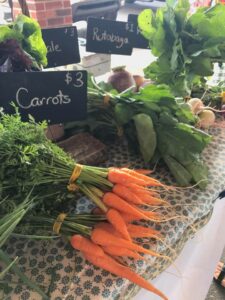What Is a Local Food System?
go.ncsu.edu/readext?842329
en Español / em Português
El inglés es el idioma de control de esta página. En la medida en que haya algún conflicto entre la traducción al inglés y la traducción, el inglés prevalece.
Al hacer clic en el enlace de traducción se activa un servicio de traducción gratuito para convertir la página al español. Al igual que con cualquier traducción por Internet, la conversión no es sensible al contexto y puede que no traduzca el texto en su significado original. NC State Extension no garantiza la exactitud del texto traducido. Por favor, tenga en cuenta que algunas aplicaciones y/o servicios pueden no funcionar como se espera cuando se traducen.
Português
Inglês é o idioma de controle desta página. Na medida que haja algum conflito entre o texto original em Inglês e a tradução, o Inglês prevalece.
Ao clicar no link de tradução, um serviço gratuito de tradução será ativado para converter a página para o Português. Como em qualquer tradução pela internet, a conversão não é sensivel ao contexto e pode não ocorrer a tradução para o significado orginal. O serviço de Extensão da Carolina do Norte (NC State Extension) não garante a exatidão do texto traduzido. Por favor, observe que algumas funções ou serviços podem não funcionar como esperado após a tradução.
English
English is the controlling language of this page. To the extent there is any conflict between the English text and the translation, English controls.
Clicking on the translation link activates a free translation service to convert the page to Spanish. As with any Internet translation, the conversion is not context-sensitive and may not translate the text to its original meaning. NC State Extension does not guarantee the accuracy of the translated text. Please note that some applications and/or services may not function as expected when translated.
Collapse ▲In my last article, I discussed the food system as a global and interconnected web, with all of its various sectors, including food production, distribution, consumption, and food waste and recovery. This month, I will dig deeper into local food systems and how they can be differentiated from the larger global food system.
While there is no fully agreed-upon definition of local foods, there are some general specificities that can be used to frame the idea of local foods. Local foods are usually referring to place-based understandings of food production, meaning that there is some geographic determination used in order to call something local. For some, that can mean anything produced directly in their community, where they are able to go directly to the food producer and purchase their products. For others, it may mean anything that is in their geographic region or their state. Many state agricultural organizations use the borders of the state to determine if something is a local product. In addition to the production of the food product, there are all of the other aspects of the food’s life including the marketing, distribution, any processing that it undergoes, and its consumption, and if those are happening in the same area that the food is produced. Depending on who you ask, something that is grown/raised/produced in one area, processed somehow in a geographically distinct area, and then returned to and sold where it was grown, may or may not fit the definition of local.
Another important cornerstone of local foods is the fact that because they are place-based, they are unique to each specific community and are shaped by the culture and values of the communities in which they are made. This also means that the specific human relationships that are involved amongst all of the people who produce and consume the foods are a key component of the local food system. When I think about community food system resiliency, my mind is primarily wondering about how well a community can adapt to changing circumstances and still meet the community’s dietary needs through food products that can be produced and distributed within that specific area. Additionally, in rural spaces, this can be incredibly important, as delivery channels from outside of the community can be broken down, as we have seen throughout the past two years. A thriving local food system can really contribute to a community’s ability to rely on itself and thrive despite external challenges and system breakdowns. Some important questions we can ask ourselves include the following. How do we ensure that all of the residents in our community are well-nourished and have all of their dietary and health needs met? These are central questions that guide the work of many who engage in local food system change efforts.
Within a local food system, it is important to have all aspects operating sustainably. This means that the environmental, economic, and relational health of every individual, business, organization, etc. is fundamental to determining the overall health of the system as a whole. Local food channels and direct-to-consumer sales channels for food producers are a key component of this, and they include food system champions such as farmers markets, agricultural cooperatives, food hubs, food relief agencies that work with local producers, restaurants that serve local foods, and direct sales on farms, through sales at produce stands and community-supported agriculture (CSA) programs. How do you engage with your local food producers? Are there ways that you could increase your support of them to keep them viable and thriving in Rutherford County?
Similar to how there are many ways of thinking about and defining local foods, there are quite a few differences of opinion on how a resilient and thriving local foods system impacts a community. Some of the main points that people often point out are the positive impacts on the local economy, via thriving businesses that provide revenue and employment for the community members, while also keeping the dollars spent in the community, supporting the community, which builds economic resiliency as well. Additionally, the health and well-being of the community members is a focus of many local food supporters, with a specific focus on food access and nutrition. When a community is able to determine what its food system looks like there is a much greater potential for food sovereignty, meaning that the collective power of the community is what determines the types of foods grown and the methods that they are grown with, including a focus on specific practices that honor the health of ourselves and our surrounding ecosystems. Local food systems are interdependent in nature and built upon networks of relationships. These include the connections between food producers and those who interact with those food products throughout the course of their creation and those who consume those products. Our relationships with the natural world around us and our own control of our health outcomes and overall well-being are also critical components. When the community decides what we want our food system to look like, what we value and want for our children and future generations, we can build a food system that reflects those values accordingly, ensuring that we are healthily sustaining ourselves and where we live, work and play, for years to come.






